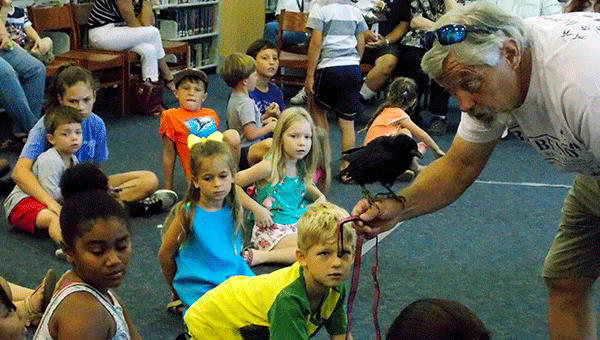Luverne library shows it can get a little wild
Published 8:10 am Friday, July 14, 2017

The Big Bend Program is hands-on and everyone had an opportunity to touch the animals. Submitted Photo
By: Scott McLendon
The public library of Luverne is home to exotic tales to be explored with imagination, but the rehabilitators from the Big Bend Wildlife Sanctuary brought live exotic tails to the audience on Friday July 7.
“We would have liked to have had more people,” said librarian Kathryn Tomlin. “But it was very educational and I was pleased with the turnout. I think we had a total of about 60 people who attended. I think the adults got out of it as much as the children did. He gave out a lot of information that I don’t think even the adults knew; I know I didn’t.”
Director Terry Morse and her husband John Morse both work as rehabilitators to sick and wounded wildlife. The Big Bend Wildlife sanctuary is nestled in Enterprise, Alabama. They are dedicated not only to the care of these orphaned or injured, but also the education of the people of Alabama and surrounding states.
“He talked about the critters he brought like the American crow and the albino blue jay, which he said was the only one in captivity in the United States,” said Tomlin. “He also brought a tiny box turtle that a dog had chewed the shell. Typically the turtle will die from this, but this one survived and started regenerating its shell. That is unheard of. He had really unique things that you wouldn’t otherwise see. They had no idea that the turtle’s shell would regenerate. They just thought he would die. It was great information and he said he’d have some different animals next year. They try to change them up. Their purpose is to reintroduce these critters into the wild if they can. The blue jay cannot be introduced back into the wild because it’s so unique that the other birds would actually kill it. Or it would have no camouflage protection in the wild. The man who found it thought it was a parakeet because of its color. Then they discovered that it was an albino blue jay. The little turtle also can’t be reintroduced to the wild because of the shape it’s in, but they’re actually studying it because his shell is regenerating. Geneticists say they don’t normally do that.”
This wildlife sanctuary is a nonprofit organization who accepts donations that are tax deductible. The organization is comprised of volunteers ranging in age and backgrounds who all care for wildlife. This wildlife rehab program began in 1988 in Blountstown, Florida by a pioneer in the field.
The BBWS was focused on the rehabilitation of the Florida black bear and returning them to the wild. The wildlife sanctuary was relocated by the Morses from the sunshine state to the wiregrass. It’s important to note that although the invitation to visit the sanctuary is open to the public, it is by appointment only.
Big Bend has stated that the program is a humane and ecological approach to resolving these problems that are often the fault of humans. The rehabilitation of these animals serves as a double-edged sword of benefits. The unhealthy animals have their vigor restored while the unwashed masses of humanity are provided with an educational opportunity.





